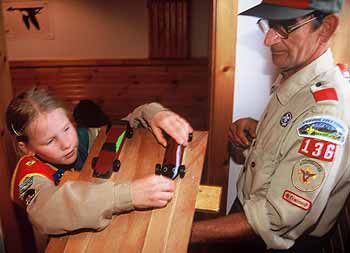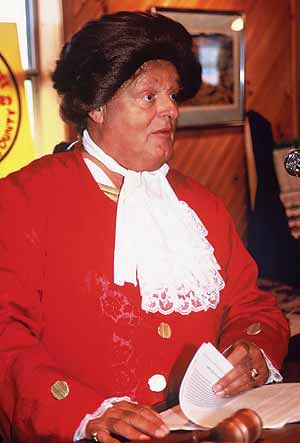Meeting at Moosehorn
By Deb Geigis Berry
Photographs By John R. Fulton Jr.
At their 42nd annual camporee, U.S. and Canadian Scouts celebrate Scouting friendship in Maine's North Woods near the site of the first permanent European settlement in North America.
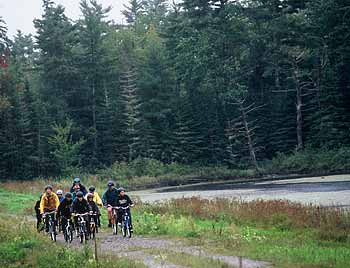 Scouts and leaders ride bikes through the huge Moosehorn National Wildlife Refuge. |
On a chilly September day, when remnants of Hurricane Ivan doused northern Maine with steady showers, dozens of Scouts from the United States and Canada gathered inside the recreation center at Moosehorn National Wildlife Refuge. They were attending the 42nd Annual Moosehorn International Camporee, co-hosted by the Washington and Hancock Districts of the Bangor, Me.-based Katahdin Area Council.
"Who will drum with us?" asked Barbara Paul, who is a Passamaquoddy, the Native American people who inhabited this area of Maine long before the arrival of Europeans. She was accompanied by the Little Eagles, a local youth drumming group.
Quick to volunteer were several Canadian and U.S. Scouts. Once the Scouts were seated around an enormous drum, its skin bearing a striking, hand painted eagle, Paul distributed sticks.
"The drum is our mother," she explained. "Easy. We don't hit our mother hard. Close your eyes and listen to the beat."
Boom-BOOM, boom-BOOM, boom-BOOM.
After a few erratic strokes, the group found their rhythm, pounding out what sounded like a heartbeat.
"It was a little hard to keep the beat," said Ian Peyton, 6, a Cub Scout visitor from Pack 127 in Alexander, Me. "But I liked it. I already knew the Passamaquoddy welcome song from school."
Roots and rhythms
Drumming set the tone in every way at the camporee, held in Calais, Me., a remote town bordering the Canadian province of New Brunswick.
"The drum is the heartbeat of a community," explained Paul, who lives southeast of the refuge in Perry. "As long as the drum is being used, the community will thrive."
The camporee was an ideal forum to familiarize youth with regional traditions, including trapping, crosscut sawing, Acadian music, and Passamaquoddy drumming.
"We share a [historical] heritage with the Canadians, but not all the Scouts are familiar with it," said camporee co-chair Rick Jamieson.
"How many have met a blacksmith? Or touched a snapping turtle?" he asked. "The camporee gives us an opportunity to better understand our ancestors. What's interesting is there are so many commonalities between some of these old traditions and Scouting traditions, like fishing, camping, and knot-tying."
St. Croix Island, now an international historic site (see sidebar), typifies the bonds between Canada and America, whose eastern portions were once known collectively as Acadie.
Today, Acadian culture still thrives in northern Maine and in parts of New Brunswick and Nova Scotia provinces. Many residents there are direct descendents of the original French settlers.
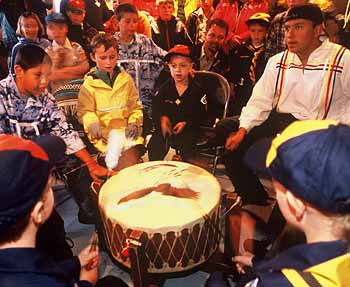 The Little Eagles, a local drumming group, perform in the Native American tradition of the Passamaquoddy. |
Jamieson and the camporee organizers were able to provide dramatic hands-on history lessons for camporee Scouts. Next to the recreation center, local blacksmiths stoked fires and helped Scouts make curved pot handles.
After firing a strip of metal, Pack 127's Ryan Peyton pounded it into a curved shape with a hammer. "I liked bending the metal and getting ashes on my hands," said Ryan, one of many Cub Scouts who visited the camporee for the day.
Acadian connections
Despite the weather, about 280 members from the BSA and Scouts Canada attended the event. "It's a chance to see old faces and keep up on the news," said Paul Potter, leader of Canada's Portland Scout troop from the borough of St. John.
"We're American and Canadian, but it's all the same brotherhood. It's comfortable to be in this environment."
As Scouts perused mounted animal displays and met a live bald eagle, assistant Scoutmaster Scott Lingley of Troop 136 in Dennysville, Me., pointed out his friends in Canadian uniforms. "We have a lot of fun with the Canadians," he said, smiling. "We kid each other a lot but in a good way."
Joking aside, the bond between the Maine Scouts and their Canadian counterparts is heartening in an age when nations are ultraprotective of their borders.
"There are open invitations across the border for a variety of Scouting events," said BSA district executive Art Washburn. "Everyone knows each other, and there's always notification going back and forth."
Even the horrible events of Sept. 11, 2001, couldn't stop the Canadian Scouts from attending the camporee that year, which was scheduled just a few days after the tragedy.
In fact, the 2001 camporee, which was councilwide, drew a record number of attendees—nearly 1,000 youth and 600 adults.
"There were so many people," remembered Washburn, "that when the Scouts started stomping their feet during one of the ceremonies, you could feel the ground shaking."
The rain reduced attendance in 2004, but it didn't dampen the spirits of Jim Runyan, Washington District chairman, who wore his biking shorts in anticipation of the annual bike ride.
"This is such a great place to go biking, [so] a little rain's not going to stop us," he declared. "You can see all kinds of interesting things [during the ride]. One year, I heard two Scouts calling from up ahead, 'We see bear cubs!'"
Although the rain kept the route shorter than the usual 25 miles, Scouts mounted their bikes, determined to savor the wild beauty of the 17,200-acre refuge.
With its majestic stands of white pines and songbird-filled woodlands, Moosehorn—home to bald eagles, coyotes, snowshoe hares, black bears, and moose—is a prime spot for a natural history lesson.
"The weather didn't bother me at all," said biker Justin Simms, 15, of St. Andrews, New Brunswick. "I was riding along the trail, and I saw a bald eagle soar overhead."
Cold temperatures also gave some campers a better appreciation of what their ancestors endured.
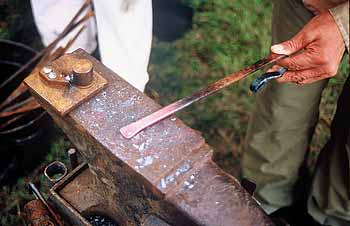 A blacksmith demonstrates skills used by early European settlers in the area. |
"The theme of St. Croix Island [historical settlement] is survival," said Michelle Stanhope, a Maine leader of Pack 136 in Dennysville/Pembroke, who has traced her lineage to the area's early settlers.
"Back then, there wasn't a Wal-Mart or a convenience store. Trapping and hunting were skills you needed to survive. That's still a way of life for many families in Washington County. This area is less populated and more traditional than other parts of the state."
At Stanhope's educational display inside the recreation center, Scouts examined various animal traps and the footprints of native creatures, including the fisher, marten, and mink.
Acadian traditions also include song, and Jean-Paul Paré-Poulain, a Franco-American chanteur from Augusta, Me., arrived in high style, ready to entertain the Scouts.
Wearing a long formal jacket, a wig, and a frilly dress shirt, he sang bittersweet French melodies.
Respecting differences
Canadian and U.S. Scouts celebrated their common heritage and also shared differences (see sidebar).
Mike Locke of Ellsworth, Me., Hancock District activities chairman, has been involved in two-nation programming for years. "These activities give us a base for friendship," said Locke, adding that he particularly appreciates the Canadian emphasis on courtesy.
"Canadian Scouts don't just walk into someone else's campsite. They follow an old tradition and say, 'Permission to enter campsite,' just as someone would knock before opening a door. That practice used to be routine in the States, but it's drifted away. It's helpful for U.S. Scouts to see it."
After a day of Acadian-style adventure, there was no rest for the weary. It was time to return to individual camps to prepare dishes, in the rain, for the campfire cooking contest.
As the sky began to darken, Scouts cooked meals over fires of wood or charcoal, hoping their concoctions would tempt the judges.
"We operate under the premise that anyone can camp in the sunshine," joked Washburn. "Besides, this was far from the worst weather we've experienced." Rain, snow, or sun—the smiles on the faces of the campers reflected the fact that the annual Moosehorn camporee provides an unforgettable Scouting experience.
Freelance writer Deb Geigis Berry lives in Windsor, Conn.
Sharing DifferencesThe Moosehorn camporee gave U.S. and Canadian Scouts a chance to share both the similarities and differences in their programs.
Founded in 1908, Scouts Canada is, like the BSA, a member of the World Organization of the Scout Movement. Some differences between Canadian Scouting and the U.S. version are minor, such as a Canadian Scout pledging to "do my duty to God and the queen." A major difference, however, is that all programs, ranging from Beavers (ages 5 to 7) to Rovers (ages 18 to 26) are coed. Only the BSA's Venturing program admits young men and women ages 14 to 21. "I have a daughter in Beavers," said Canadian troop leader Paul Potter, father of a girl and two boys, all members of Scouts Canada. "As a parent, I want her to be able to compete equally with men. There's only one way to do that. You need her to compete with boys from the start." —D.G.B. |
St. Croix: The 'Unknown' IslandJust a half-hour drive from the Moosehorn camporee site is St. Croix Island located on the St. Croix River between Canada and the United States.
The island site is recognized as the first permanent European settlement in North America. "[The first settlement] wasn't Jamestown," said camporee co-chair Rick Jamieson proudly. "It wasn't Plymouth [either]. The first settlement was right here, on St. Croix Island." In 1604, Pierre Dugua and 78 other Frenchmen crossed the Atlantic with King Henri IV's blessing to expand the fur trade. After sailing into Passamaquoddy Bay, the crew decided to erect a settlement on St. Croix Island. Unprepared for the area's harsh winters, almost half the settlers died, despite help from the Passamaquoddy Indians, who provided furs. If you have never heard of the island, you're not alone. Even some local people are unfamiliar with the area's history. That's why Jamieson and the camporee coordinators decided to put a cultural and historical spin on their program. In 2004, Canadian and American border communities marked the 400th anniversary of the St. Croix settlement with the dedication of a new cultural institution, the Downeast Heritage Center in Calais, Me., and plentiful special events. —D.G.B. |
September 2005 Table of Contents
Copyright © 2005 by the Boy Scouts of America. All rights thereunder reserved; anything appearing in Scouting magazine or on its Web site may not be reprinted either wholly or in part without written permission. Because of freedom given authors, opinions may not reflect official concurrence.
